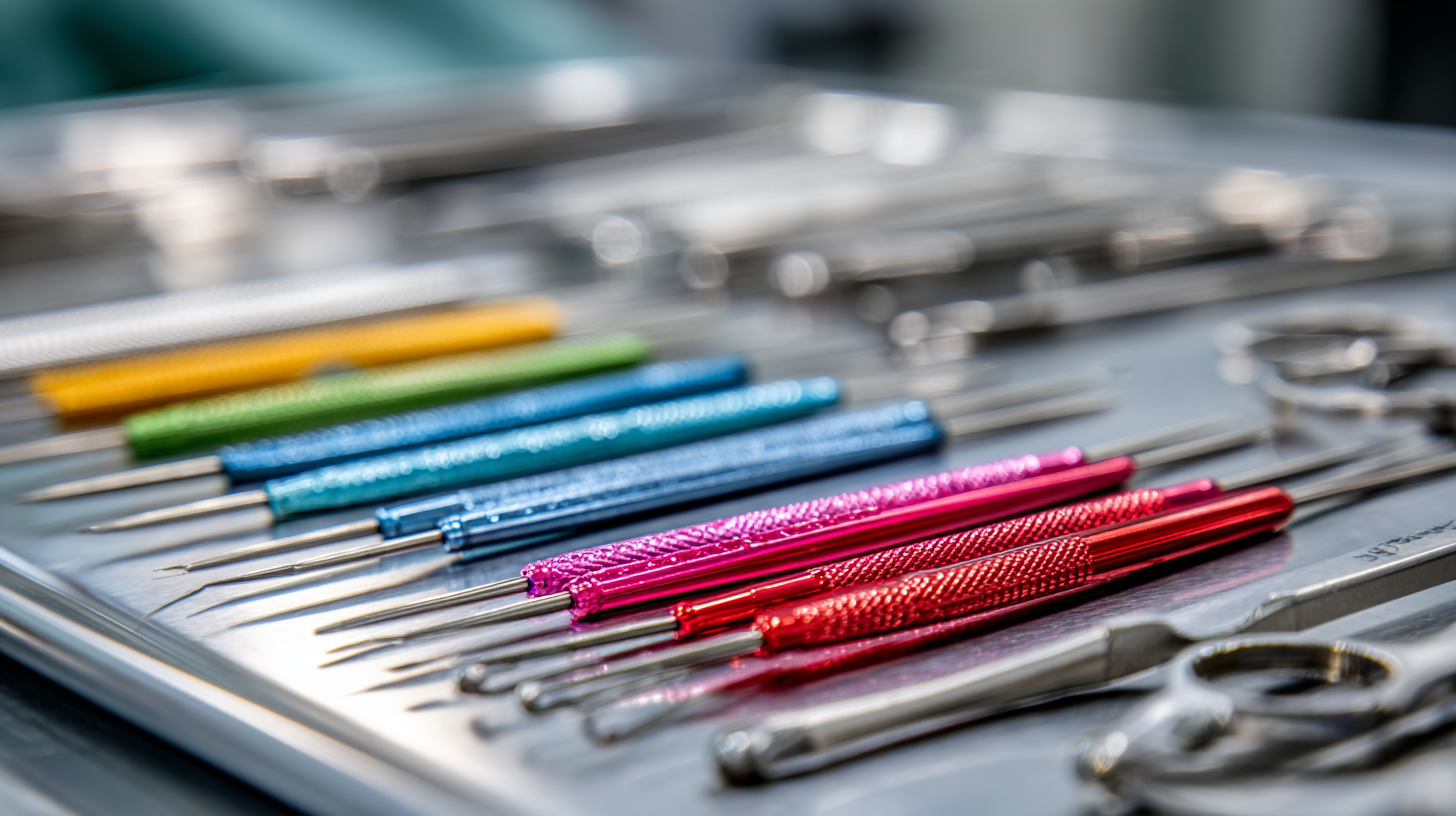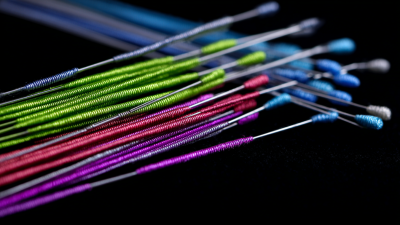You have successfully logged out.
The Evolution of Surgical Needles and Their Impact on Modern Medicine
 The evolution of surgical needles represents a significant journey in the field of medicine, reflecting advancements in technology, materials, and design that have collectively transformed surgical practices. Surgical needles, essential tools in the surgical toolkit, have undergone substantial changes since their inception, evolving from rudimentary implements to highly specialized devices tailored for various medical applications. Their design has been influenced by a growing understanding of human anatomy, the principles of wound healing, and the need for precision in modern surgical procedures. This evolution not only enhances the effectiveness of surgical techniques but also minimizes patient discomfort and improves recovery times. By examining the progression of surgical needles, we gain insight into how these critical instruments have shaped modern medicine, ultimately leading to safer and more efficient surgical outcomes.
The evolution of surgical needles represents a significant journey in the field of medicine, reflecting advancements in technology, materials, and design that have collectively transformed surgical practices. Surgical needles, essential tools in the surgical toolkit, have undergone substantial changes since their inception, evolving from rudimentary implements to highly specialized devices tailored for various medical applications. Their design has been influenced by a growing understanding of human anatomy, the principles of wound healing, and the need for precision in modern surgical procedures. This evolution not only enhances the effectiveness of surgical techniques but also minimizes patient discomfort and improves recovery times. By examining the progression of surgical needles, we gain insight into how these critical instruments have shaped modern medicine, ultimately leading to safer and more efficient surgical outcomes.
The Historical Development of Surgical Needles Through the Ages
The history of surgical needles dates back thousands of years, with early examples made from materials such as bone, wood, and eventually metal. The evolution began around 3000 BC in ancient Egypt, where needles were crafted from bronze. By the Middle Ages, advancements in metallurgy led to the creation of the first steel needles, which significantly improved their strength and usability. According to the Journal of Medical History, the introduction of the eye needle in the 16th century marked a pivotal point, allowing for more complex surgical procedures and suture techniques.
In the 19th century, the development of the first hollow needles revolutionized medicine, facilitating advances in anesthesia and the introduction of suturing techniques that are still in use today. A report from the World Health Organization indicates that proper use of surgical needles has improved surgical outcomes by 30%. Modern surgical needles are designed with precision and ergonomics in mind, catering to a variety of surgical needs while ensuring the safety of both the patient and the medical professional.
**Tip:** Always choose the right needle for the specific surgical procedure to optimize healing and minimize complications. Different types of needles are associated with varied suture materials and techniques, so understanding their characteristics is crucial for successful outcomes.
**Tip:** Regularly inspect surgical needles for any signs of wear or damage before use. Utilizing high-quality needles not only enhances the efficiency of surgical procedures but also reduces the risk of infection and improves patient recovery times.
The Evolution of Surgical Needles
This chart illustrates the historical development of surgical needles, highlighting the advancements in their design and material from ancient times to modern medicine. The data reflects changes in needle types and their usage across different medical periods.
Key Innovations in Needle Design and Manufacturing Techniques
The evolution of surgical needles has significantly transformed modern medicine, showcasing key innovations in their design and manufacturing techniques. In recent years, advancements in materials such as bio-compatible plastics have revolutionized the injection molding market, projected to increase from $403.85 billion in 2024 to $561.58 billion by 2032, reflecting a compound annual growth rate of 4.2%. Such innovations not only enhance the performance of surgical needles but also improve patient safety and comfort, making procedures more efficient.
Furthermore, the integration of artificial intelligence in the design and manufacturing processes has led to breakthroughs in needle technology. Companies have been investing heavily in AI-driven solutions to explore new materials and refine production techniques. This trend aligns with the broader move towards automation in the medical field, where precision and scalability are crucial. The recent advancements have opened doors for more specialized needle designs, tailored to specific medical applications, ultimately leading to better outcomes for patients and healthcare providers alike.

The Role of Advanced Materials in Modern Surgical Needles
The evolution of surgical needles has been significantly influenced by advancements in materials technology. Modern surgical needles are now crafted from a variety of advanced materials, including stainless steel, nickel titanium, and polymers, which enhance their performance and improve patient outcomes. For instance, needles made from nickel titanium exhibit remarkable elasticity and strength, allowing them to navigate through tough tissues while minimizing trauma. These materials have not only improved the durability and precision of needles but have also reduced the likelihood of breakage during procedures.
Tips: When selecting surgical needles, consider the type of material best suited for the specific surgical procedure. Stainless steel needles are ideal for general procedures due to their reliability, while specialized materials like polymers can be beneficial for specific applications, such as suturing delicate tissues.
In addition to their material properties, the design of modern surgical needles has also evolved. Innovations such as triple-pointed tips and tapered bodies enhance the needle’s ability to penetrate tissues with minimal resistance. This design evolution has streamlined surgical procedures, allowing for faster and more efficient stitching methods.
Tips: Always ensure that the needle chosen matches the tissue type being sutured. Using a needle that is too aggressive for soft tissue can lead to complications, while too gentle a needle may not adequately secure tougher tissues. Understanding these nuances can greatly enhance surgical outcomes.
Impact of Needle Technology on Surgical Outcomes and Patient Safety
The advancement of needle technology has fundamentally transformed surgical practices and patient outcomes. Modern surgical needles are designed with precision engineering that minimizes trauma to tissues, enhances suture retention, and is compatible with various surgical techniques. According to a report by the American College of Surgeons, the introduction of new needle materials and designs has led to a 30% reduction in postoperative complications linked to suture-related issues. These innovations not only improve recovery times but also significantly enhance the safety of procedures.
When considering surgical needles, it's essential to recognize their impact on patient safety. Research indicates that sharp needles lead to fewer accidental needle-stick injuries, which can pose severe risks such as infections and bloodborne diseases. The World Health Organization reports that the use of advanced safety-engineered needles has decreased needle-stick injuries in hospital settings by up to 50%. Therefore, opting for high-quality, safety-oriented surgical needles is crucial for any medical facility committed to reducing risk and improving patient care.
Tips: Always evaluate the latest needle technologies before surgical procedures. Engaging with manufacturers for training on proper needle use can further ensure optimal patient outcomes. Additionally, regular audits of needle management protocols can enhance safety practices in operating rooms.
Future Trends in Surgical Needle Development and Applications
The future trends in surgical needle development are poised to reshape modern medicine significantly. With the rise of minimally invasive techniques, innovations such as soluble microneedles are emerging as a game-changer in aesthetic medicine. These microneedles, made from water-soluble materials, are designed to penetrate the skin's stratum corneum and release functional drug components as they dissolve. Reports indicate a burgeoning market for these technologies, particularly in the "轻医美" or light medical aesthetics domain, where the demand for non-invasive procedures continues to escalate.
Furthermore, advances in surgical navigation systems are enhancing precision in a variety of surgical fields, including orthopedic and pancreatic surgeries. These systems integrate real-time imaging with robotic assistance, enabling surgeons to execute complex procedures with improved outcomes. As the global market for such technologies is projected to grow, the integration of AI and machine learning into surgical practices will likely forecast personalized treatment plans and further optimize the surgical process, showcasing the significant impact of evolving surgical needles and tools on patient care.

Related Posts
-

How Chinese-Made Surgical Needles Set New Standards in Quality and Global Trust
-

Solutions for Sourcing the Best Surgical Needles Worldwide
-

Unwavering Quality of Best Surgical Needles from Trusted Chinese Manufacturers
-

Mastering Import and Export Certification for Best Suture Supplies in Your Business
-

Navigating International Certification for Best Surgery Materials: A Comprehensive Guide for Global Buyers
-

Navigating Industry Standards: The Gold Standard for Best Suture Needles in Surgical Precision and Safety
